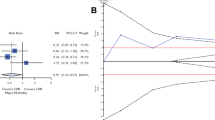Summary
High morbidity and mortality rates are reported for bypass and resective surgery of pancreatic cancer. In a retrospective study we correctly predicted the postoperative course in 88% of the patients who underwent bypass surgery and 83% of those who had a resection for pancreatic cancer. Before starting with clinical application of this scoring system, we undertook a prospective study to confirm its predictive value. Sixtyseven consecutive patients with pancreatic cancer were included: 42 patients underwent bypass surgery and 25 pancreatic resections. The operative mortality was 14% for palliative surgery and 0% for resective surgery. Surgical team and nurses were totally unaware of the predicted risk. The preoperative forecast proved to be correct in 81% of bypass surgery and in 88% of resective surgery, although surgical mortality had decreased from 21 to 14% for bypass surgery and from 17 to 0% for resective surgery. Tables are included to calculate the surgical risk for each of 162 combinations of the risk factors considered in the predictive model (81 for bypass surgery and 81 for resective surgery). Calculation of surgical risk is important when evaluating different treatments for pancreatic cancer are available.
Similar content being viewed by others
References
Sarr GH, Cameron JL. Surgical management of unresectable carcinoma of the pancreas:Surgery 1982; 91: 123–133.
Braasch JW, Gray BN. Considerations that lower pancreato-duodenectomy mortality.Am J Surg 1977; 133: 480–484.
Andren-Sandberg A, Ihse I. Factors influencing survival after total pancreatectomy in patients with pancreatic cancer.Ann Surg 1983; 198: 605–610.
Morrow M, Hilaris B, Brennan MF. Comparison of conventional surgical resection, radioactive implantation, and bypass procedures for exocrine carcinoma of the pancreas, 1975-1980.Ann Surg 1984; 199: 1–5.
Warshaw AL, Swanson RS. Pancreatic cancer in 1988.Ann Surg 1988; 208: 541–553.
Brooks JR, Brooks DC, Levine JD. Total pancreatectomy for ductal cell carcinoma of the pancreas.Ann Surg 1989; 209: 405–410.
Nakase A, Matsumoto Y, Uchida K, Honjo I. Surgical treatment of cancer of the pancreas and periampullary region: Cumulative results in 57 Institutions in Japan.Ann Surg 1977; 185: 52–57.
Edis AJ, Kiernan PD, Taylor WF. Attempted curative resection of ductal carcinoma of the pancreas.Mayo Clin Proc 1980; 55: 531–536.
Moreaux J, Catala M, Marzano L. Les resultats du traitement chirurgical du cancer du pancreas.Gastroenterol Clin Biol 1984; 8: 11–16.
Grace PA, Pitt HA, Tompkins RK, DenBesten L, Longmire WP. Decreased morbidity and mortality after pancreatoduodenectomy.Am J Surg 1986; 151: 141–147.
Braasch J, Rossi RL, Watkins E, Deziel DJ, Winter PF. Pyloric and gastric preserving pancreatic resection.Ann Surg 1986; 204: 411–418.
Van Heerden JA, McIlrath DC, Ilstrup DM, Weiland LH. Total pancreatectomy for ductal adenocarcinoma of the pancreas: An update.World J Surg 1988; 12: 658–662.
Ishikawa O, Ohhigashi H, Sasaki Y, Kabuto T, Fukuda I, Furukawa H, Imaoka S, Iwanaga T. Practical usefulness of lymphatic and connective tissue clearance for the carcinoma of the pancreas head.Ann Surg 1988; 208: 215–220.
Trede M, Schwall G. The complications of pancreatectomy.Ann Surg 1988; 207: 39–47.
Lygidakis NJ, van der Hyde MN, Houthoff HJ, Schipper MEI, Huibregtse K, Tytgat GNJ, Lubber MJ, Reeders JWAJ, Bosey MMEM, Oosting J. Resectional surgical procedures for carcinoma of the head of the pancreas.Surg Gynecol Obstet 1989; 168: 157–165.
Gilsdorf RB, Spanos P. Factors influencing morbidity and mortality in pancreaticoduodenectomy.Ann Surg 1973; 177: 332–337.
Chapuis Y, Catala H, Place S. A propos du proces verbal. Reflexions sur le traitement des cancers du pancreas.Chirurgie 1983; 109: 357–358.
Yamanaka H, Nishi M, Kanemaki T, Hosoda N, Hioki K, Yamamoto M. Preoperative nutritional assessment to predict postoperative complication in gastric cancer patients.JPEN 1989; 13: 286–291.
Buzby GP, Mullen JL, Matthews DC, Hobbs CL, Rosato EF. Prognostic nutritional index in gastrointestinal surgery.Am J Surg 1980; 139: 160–167.
Christou NV, Tellado-Rodriguez J, Chartrand L, Giannas B, Kapadia N, Meakins J, Rode H, Gordon J. Estimating mortality risk in preoperative patients using immunologic, nutritional, and acute-phase response variables.Ann Surg 1989; 210: 69–77.
Halliday AW, Benjamin IS, Blumgart LH. Nutritional risk factors in major hepatobiliary surgery.JPEN 1988; 12: 43–48.
Pedrazzoli S, Bonadimani B, Sperti C, Cappellazzo F, Piccoli A, Militello C. Forecast of surgical risk in pancreatic cancer.Am J Surg 1987; 153: 374–377.
Hermreck A, Thomas C, Friesen J. Importance of pathologic taging in the surgical management of adenocar cinoma of the pancreas.Am J Surg 1974; 127: 650–653.
Molnar W, Stockum AE, Relief of obstructive jaundice through percutaneous transhepatic catheter—a new therapeutic method.American Journal of Roentgenology (Baltimore, MD) (AJR) 1974; 122: 356–367.
Nakayama T, Ikeda A, Okuda K. Percutaneous transhepatic drainage of biliary tract. Technique and results in 104 cases.G astro enterology 1978; 74: 554–559.
Siegel JH, Snady H. The significance of endoscopically placed prostheses in the management of biliary obstruction due to carcinoma of the pancreas: results of nonoperative decompression in 277 patients.Am J Gastroenterol 1986; 81: 634–641.
Coons HC. Self-expanding stainless steel biliary stents.Radiology 1989; 170: 979–983.
Hyoty MK, Nordback IH. Biliary stent or surgical bypass in unresectable pancreatic cancer with obstructive jaundice.Acra Chir Scand 1990; 156: 391–396.
Author information
Authors and Affiliations
Rights and permissions
About this article
Cite this article
Pedrazzoli, S., Bonadimani, B., Sperti, C. et al. Evaluation of surgical risk in palliation and resection of pancreatic cancer. Int J Pancreatol 12, 219–226 (1992). https://doi.org/10.1007/BF02924360
Received:
Revised:
Accepted:
Issue Date:
DOI: https://doi.org/10.1007/BF02924360




